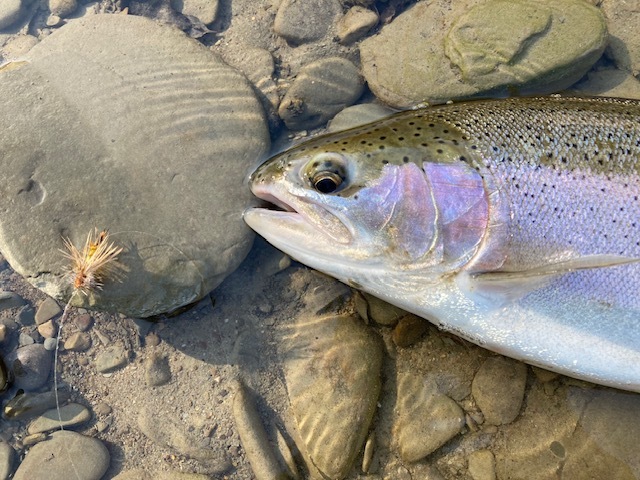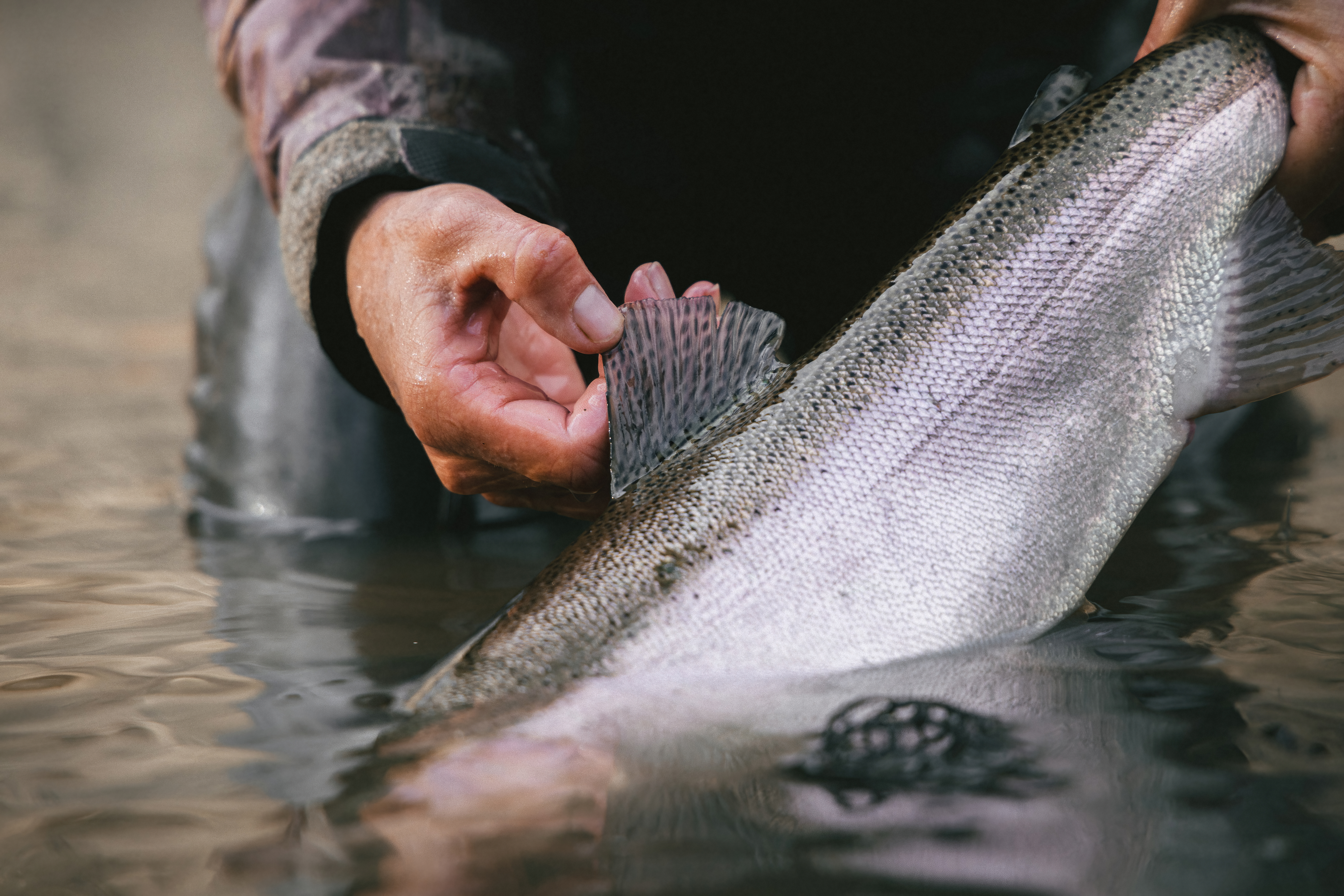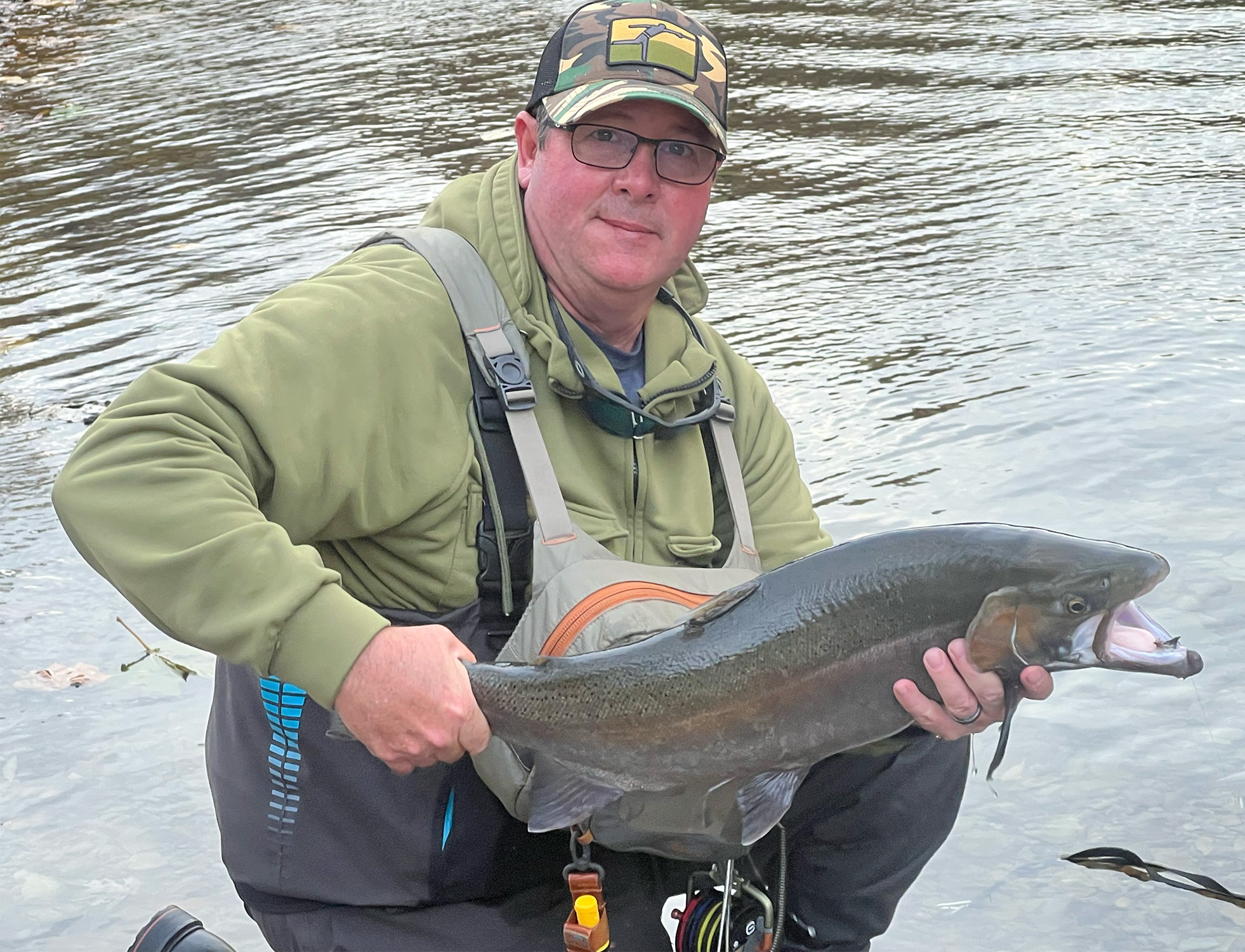Low Water Fly Fishing Techniques for Steelhead: How To Catch Steelhead in Low and Clear Water
By: Karl Weixlmann
October 1, 2025
It’s been a long summer, and the Shack Nasties are getting to you. Cooler nights where you leave your bedroom windows open, dew on the grass in the morning, hardwood leaves beginning to change color, and maybe a few spurts of precipitation, all signal phenological changes in the environment that tell you it’s time to get hooked up with some steelhead. The fact remains, though, that for the last couple of seasons on Steelhead Alley, water conditions have been extremely poor. Even the largest tributaries have had half the volume and flow of water in what would normally be perceived as low water conditions. Things were drastic, with good guides canceling many of their trips. Yet, even though the last couple of seasons will hopefully be an anomaly, steelheaders throughout the Great Lakes will at some time or another be faced with low, clear water conditions during any part of the season. The following are a few of the techniques and tackle requirements I’ve learned over the last 25 years that should help you stick more fish in the net under these conditions.
It’s been a long summer, and the Shack Nasties are getting to you. Cooler nights where you leave your bedroom windows open, dew on the grass in the morning, hardwood leaves beginning to change color, and maybe a few spurts of precipitation, all signal phenological changes in the environment that tell you it’s time to get hooked up with some steelhead. The fact remains, though, that for the last couple of seasons on Steelhead Alley, water conditions have been extremely poor.
Even the largest tributaries have had half the volume and flow of water in what would normally be perceived as low water conditions. Things were drastic, with good guides canceling many of their trips. Yet, even though the last couple of seasons will hopefully be an anomaly, steelheaders throughout the Great Lakes will at some time or another be faced with low, clear water conditions during any part of the season. The following are a few of the techniques and tackle requirements I’ve learned over the last 25 years that should help you stick more fish in the net under these conditions.
Table of Contents
The Dry Alone

I mean, who doesn't want to catch a steelhead on a dry fly, especially after you've refined all your subsurface techniques and are looking for a new challenge? Why not free yourself from all that cumbersome terminal tackle used when indicator nymphing? Why not get back to a fly fisherman’s original state of being and enjoy actual fly casting again? It doesn't make you a snob, because no matter how we fish, we fish for self-satisfaction.
Classic upstream casting with a dry fly is one of an inland trout angler's most delightful experiences, and dead drifting a dry on Steelhead Alley in this manner will sometimes take fish.
Fly fishers who have spent a degree of time on our tributaries have probably watched one come up and eat the indicator itself. This technique is so much more effective when fishing droppers that I rarely fish this way with the dry alone.
Because I’d rather watch them chase and eat it! You see, that V wake that you can create on a down and across stream cast can really turn them on, on certain days. It triggers that predatory instinct, kind of like a bear chasing a human that is running away, but with much more pleasurable results. The crash of water as the steelhead charges the fly and engulfs it in front of you is nothing less than magic.
On coastal rivers west of the Rocky Mountains, most dry fly presentations to steelhead migrating from the Pacific Ocean are made down and across currents, where the belly in the floating fly line creates the wake of the fly as it drifts downstream. On most Alley tribs where steelhead are holding in slow, deeper water, you have to create the wake yourself because there is no current pushing on the fly.
Let's say you're walking downstream and spot a pod of fish holding in a bottom depression before the tailout. While casting down and across, check the cast so the dry fly flutters down softly upstream and on the far side of the group of fish. As the fly floats in front of the fish, draw the rod back towards you to give the fly movement, which will produce that noticeable V wake
on the surface of the water.
If the fish are interested, you might see one or two fish slide out from the pod and start to follow it. Whatever you do, don't stop it. Sometimes you might have to lean back and bring the tip of the rod past your shoulder to continue the wake. There have also been times when fishing from the bank, where I’ve actually had to walk backwards upstream to keep that wake going.
It’s not easy to keep a steady wake going by stripping in the fly line, and you may even want to increase the speed of the wake to keep a fish interested. If you get followers from several fish that return to their holding position, most likely to the group from whence they came, those fish are interested and can be caught. Try to target them individually because out of a group of steelhead, only one or two may be susceptible to coming to the surface and eating.
I’ve had enough success with Stimulator-style dry flies that I don’t often see a need for others, although if I want to go old school nostalgic, a split-wing Bomber puts out an even bigger wake.
Modern foam body patterns like a Waller Waker developed for real ocean running west coast fish would probably work too.
Dry Fly Droppers
Think about it. We’ve had several precipitation events that raised water levels, bringing in fresh runs of steelhead that have started to spread out and up into our tributaries. Then the water levels drop like a rock, literally stranding steelhead in the deepest pools from which they cannot escape until the next rise in water. This is why Steelhead Alley receives so much fishing pressure. It’s because people can see them.
These fish get bombarded with every type of bobbers, baits, lures, and flies that you could imagine. They get real spooky and take odd holding positions in little to no current, often facing downstream because this is where the deepest water is. Forget about running a real drift.
Even the smallest split shot or indicator blooping into the water would spook them, making them swim around in circles.
So I thought, what is the most unobtrusive fly fishing technique I could use for these fish, many of which were suspended in the water column? It was then that I started to use dry fly and dry fly dropper techniques because a dry fly lands on the surface of the water with little to no disturbance, and I could do several different things with it. I could use just the dry fly and cast down and across, then create a wake with it. I could fish the dry up and across and dead drift it, or I could fish a dry with a dropper up and across with a reach cast to keep the fly line off the fish and prevent it from spooking them.
Now, dry fly dropper techniques for inland trout have been around for a long time, but I had never heard or read about using them for steelhead. I soon found out that the technique made what I thought were uncatchable fish catchable and that I could have success on steelhead in the poorest water conditions you could possibly encounter. The second thing I learned was that you have to be precise. Precise in your casting so as not to spook fish from the fly line landing on the water, and precision with the depth of the dropper underneath the dry fly.
Terminal Tackle Rigging
Long 10’ to 12’ nylon (because it floats) tapered leaders to 3x are needed to keep the fly line away from fish, and I use 4x fluorocarbon (because it sinks) for attaching the dropper fly. Every now and then, I might go 5x (approx. 4.5 lb.) to the dropper, but I’d rather have a reduction in takes than an increase in breakoffs. I tie all this together with improved clinch knots, with the dropper length tied to the bend of the dry fly hook.
When dry fly dropper fishing for steelhead, your dry fly is actually acting as your indicator, landing softly on the water, so just about any big, bushy dry fly will work in larger sizes from a size #10 to #6. I like to use a Yellow Stimulator because the hollow elk hair wing, tail, and wound hackle through the abdomen and thorax gives it good floatability, enough to maintain that floatability when using a weighted bead head nymph or microshot placed between the dry and dropper. Another reason that’s even better is that I can see it.
One of the few times I'll use this microshot placement is if I’m using an egg pattern dropper because most egg patterns will not sink under the dry fly fast enough to get a drag-free drift, though you should still saturate the egg with water before casting. Sometimes you might need a deep set with a nymph, so I like weighted nymphs that sink quickly under the dry, even with shallower settings.
The perfect nymph for this is a black Copper John that makes a good stonefly imitation and is tied with a black wire abdomen that gives it a faster sink rate. When the water is super low and clear under the conditions we are talking about, I’m going to start with a size #16 before making any changes up or down in size, though I’m sure other nymph patterns have the possibility of working just as well.
Your dropper depth is essential in order to get takes, and I want that nymph to get under that dry as quickly as possible, drifting as close to a 90-degree angle as you can get it. As I said earlier, the fish are often suspended, especially in early fall. My theory as to why they do this is because this is the only place they can find any current in deeper water, and they need current in order to intake oxygen in those warmer water temps. So sometimes you’ll see them hovering near the surface, which requires a shallow dropper depth. Sometimes you’ll see them stacked at different water depths, so you’ll want to pick them off from the top down to reduce any chance of foul hooking.
During our winter season, when the only precipitation events we have consist of snow, and water temperatures plummet, lowering and clearing tributary conditions, steelhead will often be found in the same places they were in early fall, deep, slow pools with little current, except now they are holding tight to the bottom. I believe those oval sores found on the bellies of some steelhead at this time come from those super-cooled shale bottom substrates that they lie upon.
This may not at first seem to be the time to break out dry fly dropper techniques because there is little chance of the dry fly getting an eat, but presentation-wise, it can be more deadly than any other. Once again, the fish can be easily seen, appearing as dark torpedoes lying on the bottom, yet they are not as easily spooked because their metabolism has slowed down, and they don’t want to expend as much energy swimming around.
Exact dropper length is absolutely essential as you want to place the dropper fly right in front of a steelhead's face, and many times you need to play around with it. Once again, we want a vertical 90-degree angle to the nymph straight underneath the dry. The easiest way to figure this out is to find a similar depth nearby, throw the rig out close enough to observe, and watch what happens to the nymph as it sinks. You want it riding inches from the bottom. If you are set too deep, your dry fly will actually stall on the drift and sink slowly because your nymph has touched the bottom.
Terminal Tackle for Dry Fly Dropper Steelhead Fishing
- RIO Steelhead/Salmon Tapered Leader 3-Pack - 8lb
- Frog Hair 100% Fluorocarbon Tippet - 4x
- Raven Super Soft Split Shot (when using egg pattern flies as a dropper) - Size 6
Flies for Dry Fly Dropper Steelhead Fishing
- Stimulator Dry Fly - 2 Pack - Size #10, Black or Yellow (if tying yourself, don’t be afraid to go up to size #6 or #8)
- Bead Head Copper John Nymph - 2 Pack - Black, Size #16 (can upsize depending on conditions and mood of fish)

The New Wave
Last fall, at a Mayfly Project fundraiser held on Elk Creek in Erie County, Pennsylvania, I witnessed a technique and tackle setup that I had never thought would work in these conditions or seen in action, yet it excelled in producing fish in the worst water levels I’ve ever seen on that tributary. One of the organizers and a good friend, Joe Pewdo, brought along a Euro Nymphing fly rod.
Now I’ve been a little late getting into the whole Euro Nymphing game, even though the first time I tried it, I caught a steelhead on my fourth cast. Euro Nymphing can be categorized into a new way of doing the old “chuck and duck” with much more refined and lighter terminal tackle and fly rods. You're basically just flipping out weighted flies on straight mono.
A couple of us went immediately to the dry dropper setup because of the conditions. We hooked into some fish right away that were lost because of the delicate terminal tackle and the new participants to fly fishing. Joe came along with his long Euro rod and proceeded to put more fish in the net than we had. I recently asked him about it.
“That morning, I talked to Jack Barr (another guide graciously giving his time), and he told me that on the previous day, he was catching steelhead on a black Stimulator dry fly. I didn’t have any black Stimulators, so I put on a size #8 black bugger attached to 6 feet of 4x fluorocarbon from the sighter section. When it got wet, it added some weight to the fly so I could cast it out where it needed to go. The beauty of a good Euro fly rod is that it casts light stuff well.”
So then I had to talk to Jack about his previous day's fishing, and once again I learned something new. “ We fished the beach in the morning and were on our way to Elk Creek. I knew I needed some dry flies because of the low water conditions, so we stopped at FishUSA and picked up some black Stimulators.” Jack then told me the way they were able to catch them. “ We targeted the bucks (steelhead of the male persuasion) that were chasing each other around. When one buck chased another and came back to the position from which it started, it didn’t necessarily matter what kind of presentation it was, as long as you placed the fly within its sight window. They would come up and crush it!”

Euro Nymphing Rods for Steelhead
- Orvis Clearwater Freshwater Fly Rod - 10’5wt
- St. Croix Imperial USA Fly Rod - 10’6wt
Final Thoughts
All of us steelheaders are sure praying for rain, and more rain, and more rain, to bounce back from the rather dismal water conditions we’ve been facing as of late. Sure, everyone wants to fish high water on the drop, but sometimes we have no choice in the matter and have to adjust our techniques and methods to the situations we face. If you want to keep it bent, try doing something different this season.

